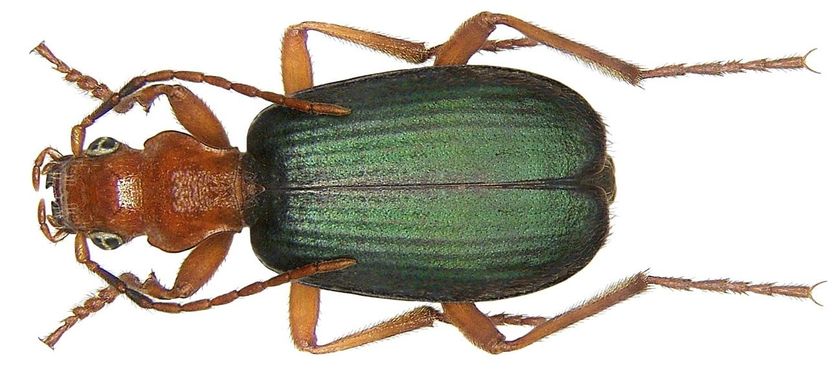These special beetles defend themselves by bombing their enemies. They can set off small explosions of irritating chemicals intended to deter potential predators. Hence their name.
![Bombardier beetle of the species Stenaptinus insignis projecting its chemical weapon. / [link]BBC[/link].](https://cms.evangelicalfocus.com/upload/imagenes/640b42b35e685_63f78e9e4d45d_Escarabomb1170940.jpg) Bombardier beetle of the species Stenaptinus insignis projecting its chemical weapon. / [link]BBC[/link].
Bombardier beetle of the species Stenaptinus insignis projecting its chemical weapon. / [link]BBC[/link].
The world of the Coleoptera – otherwise known as beetles – is extremely diverse. There are around 400,000 known species on the planet.
Someone once quipped that God must be very fond of these insects, as it is one of the most numerous animal groups in the biosphere. In the Carabidae there is a group known as coleoptera, which includes the so called “brachininae”, that is to say, very special beetles in that they defend themselves by bombing their enemies. They can set off small explosions of irritating chemicals intended to deter potential predators. Hence their name, “bombardier”.
They are not rare insects as more that 250 species have been identified across all continents, except the Antarctic, and they all possess this explosive property. The secret is in the underside of its abdomen in which there are two compartments separated by a miniscule sphincter that can open or close. The first compartment is a bladder which collects oxygenated water and hydroquinone (an aromatic organic compost), products which are separated by secreting lobes on the animal, whereas the second compartment is the explosion chamber, as between the cells that form its walls there are glands which separate the catalase enzyme involved in the destruction of the oxygenated water (or hydrogen peroxide) which is generated during the cells metabolism.
When the mixture of oxygenated water and hydroquinone and the collection bladder makes contact with the catalase enzyme in the explosion chamber, there is an explosion which releases a boiling liquid at 100º C through the exit orifice. This liquid is irritating and can damage the skin of any predator, but no harm is done to the beetle because it has special valves which close, thus preventing the explosion from back-firing.
The animal, as it feels threatened, contracts the muscles surrounding the bladder at the same time as it relaxes the sphincter. The exit orifice muscles can aim the jet at the enemy, which receives a shower of the toxic chemical quinone. On occasions, this operation can also occur inside the mouth, the throat or the stomach of the predator – whether it is a toad, a lizard or a bird – and in a matter of minutes the insect is regurgitated alive.
How could a system like this have evolved slowly and gradually? Can chance act like a chemical engineer? This organ could not possibly be the result of gradual evolution, as the slightest modification in the chemical equilibrium would have killed the insect. It had to be a fully functional system from the start. Neo-Darwinism is incapable of explaining how this particular defence mechanism could have evolved.

[photo_footer] Bombardier beetle of the species Brachinus crepitans, distributed in Europe and the western half of Asia / Wikipedia.[/photo_footer] The evolutionist Richard Dawkins maintains that the ancestors of the bombardier beetle must simply have given a different function to chemical substances which already existed and which were used for other purposes, as that is how evolution works. This is the so-called “preadaptation”. However, this explains absolutely nothing, and, besides, it causes confusion. If the organs are formed, as Neo-Darwinism supposes, by small successive changes, it is not possible for them to be functional from the beginning.
For example, it birds’ wings had been formed little by little from the legs of a small descendent of the dinosaur, what would have been the purpose of the wing stumps or embryos, and why would they have to be indispensable? In the same way, it is hard to imagine what could have been the primitive and incipient function of such an explosive mixture as is possessed by this type of beetle. Its peculiar defence mechanism had to be able to function properly, with absolute precision, from the word go. Otherwise, the poor little animal would have blown up thousands of times, which would have been the end of its supposed evolution. This apparatus speaks rather of creation and design, rather than random evolution.
The defence system of the bombardier beetle has so many other molecular components (tens of thousands of different molecules) that it is impossible to establish how each of them came about, or to speculate about which type of mutation could have given rise to them so that the apparatus could have evolved effectively. They are proteins which are particularly resistant to heat, and separated from the animal’s digestive tract, and made up of parts which interact with each other. It is disputable whether evolution could have produced large, sophisticated structures like these. It is as speculative as when 19th century naturalists tried to account for the origin of the cell by spontaneous generation. These are absurd, fruitless discussions, unable to lead to any clear conclusion because they are not realistic, the component parts are unknown, and the possible intermediary steps that are required remain a mystery.
In my opinion, there can be no doubt that irreducibly complex mechanisms like this one are weighty obstacles which belie Darwinian explanations. And, likewise, they reaffirm the idea of an original creation, as they are structures which had to be functional from the very start. The author of Ecclesiastes was right when he wrote that no one understands the work that God has done, from the beginning to the end (Ecclesiastes 3:11).
Antonio Cruz, biologist and author of several books on science and faith.
[donate]

Las opiniones vertidas por nuestros colaboradores se realizan a nivel personal, pudiendo coincidir o no con la postura de la dirección de Protestante Digital.
Si quieres comentar o